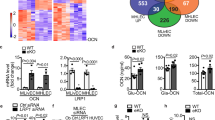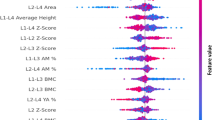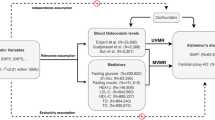Abstract
Aim:
Osteocalcin, a biochemical marker of bone formation, has been suggested to be involved in the regulation of energy metabolism. The aim of this study was to investigate the possible association between serum osteocalcin and markers of glucose and lipid metabolism in a large sample of healthy Chinese women.
Methods:
A total of 2032 healthy Chinese women in Shanghai, aged 20–94 (including 1396 discovery-study subjects and 636 postmenopausal women for a reduplication analysis) were recruited. Their serum osteocalcin, calcium and the relevant measurements were analyzed. A Spearman correlation analysis was performed between osteocalcin and the other markers of energy metabolism including triglyceride, total cholesterol, fasting plasma glucose (FPG), serum insulin, body mass index and homeostasis model assessment-insulin resistance. Separate multiple regression analyses were performed with data from the discovery and reduplication subjects to determine whether serum osteocalcin concentration was an independent predictor of the glucose or lipid metabolism markers.
Results:
For the discovery-study subjects, serum osteocalcin was found to be negatively associated with weight (r=−0.08, P=0.002), BMI (−0.13, P<0.001) and FPG (r=−0.13, P=0.001). Similar results were also found in the reduplication subjects (weight: r=−0.19, P=0.016; BMI: r=−0.23, P=0.003; FPG: r=−0.28, P<0.001). In the multiple regression analysis, serum osteocalcin was revealed as a potential independent predictor for FPG (β=−0.07 and –0.210 for discovery and reduplication, respectively, P<0.01) and BMI (β=−0.127 and –0.299 for discovery and reduplication, respectively, P<0.01).
Conclusion:
Serum osteocalcin is negatively associated with weight BMI and FPG in healthy Chinese women. Therefore, osteocalcin might contribute to obesity and diabetes.
Similar content being viewed by others
Log in or create a free account to read this content
Gain free access to this article, as well as selected content from this journal and more on nature.com
or
References
Price PA . Gla-containing proteins of bone. Connect Tissue Res 1989; 21: 51–7; discussion 57–60.
Delmas PD . Biochemical markers of bone turnover for the clinical investigation of osteoporosis. Osteoporos Int 1993; 3 Suppl 1: 81–6.
Luukinen H, Kakonen SM, Pettersson K, Koski K, Laippala P, Lovgren T, et al. Strong prediction of fractures among older adults by the ratio of carboxylated to total serum osteocalcin. J Bone Miner Res 2000; 15: 2473–8.
Lenora J, Ivaska KK, Obrant KJ, Gerdhem P . Prediction of bone loss using biochemical markers of bone turnover. Osteoporos Int 2007; 18: 1297–305.
Rached MT, Kode A, Silva BC, Jung DY, Gray S, Ong H, et al. FoxO1 expression in osteoblasts regulates glucose homeostasis through regulation of osteocalcin in mice. J Clin Invest 2010; 120: 357–68.
Lee NK, Sowa H, Hinoi E, Ferron M, Ahn JD, Confavreux C, et al. Endocrine regulation of energy metabolism by the skeleton. Cell 2007; 130: 456–69.
Zhou M, Ma X, Li H, Pan X, Tang J, Gao Y, et al. Serum osteocalcin concentrations in relation to glucose and lipid metabolism in Chinese individuals. Eur J Endocrinol 2009; 161: 723–9.
Shea MK, Gundberg CM, Meigs JB, Dallal GE, Saltzman E, Yoshida M, et al. Gamma-carboxylation of osteocalcin and insulin resistance in older men and women. Am J Clin Nutr 2009; 90: 1230–5.
Pittas AG, Harris SS, Eliades M, Stark P, Dawson-Hughes B . Association between serum osteocalcin and markers of metabolic phenotype. J Clin Endocrinol Metab 2009; 94: 827–32.
Kindblom JM, Ohlsson C, Ljunggren O, Karlsson MK, Tivesten A, Smith U, et al. Plasma osteocalcin is inversely related to fat mass and plasma glucose in elderly Swedish men. J Bone Miner Res 2009; 24: 785–91.
Kanazawa I, Yamaguchi T, Yamamoto M, Yamauchi M, Kurioka S, Yano S, et al. Serum osteocalcin level is associated with glucose metabolism and atherosclerosis parameters in type 2 diabetes mellitus. J Clin Endocrinol Metab 2009; 94: 45–9.
Kanazawa I, Yamaguchi T, Sugimoto T . Relationship between bone biochemical markers versus glucose/lipid metabolism and atherosclerosis; a longitudinal study in type 2 diabetes mellitus. Diabetes Res Clin Pract 2011; 92: 393–9.
Im JA, Yu BP, Jeon JY, Kim SH . Relationship between osteocalcin and glucose metabolism in postmenopausal women. Clin Chim Acta 2008; 396: 66–9.
Iki M, Tamaki J, Fujita Y, Kouda K, Yura A, Kadowaki E, et al. Serum undercarboxylated osteocalcin levels are inversely associated with glycemic status and insulin resistance in an elderly Japanese male population: Fujiwara-kyo Osteoporosis Risk in Men (FORMEN) Study. Osteoporos Int 2012; 23: 761–70.
Fernandez-Real JM, Izquierdo M, Ortega F, Gorostiaga E, Gomez-Ambrosi J, Moreno-Navarrete JM, et al. The relationship of serum osteocalcin concentration to insulin secretion, sensitivity, and disposal with hypocaloric diet and resistance training. J Clin Endocrinol Metab 2009; 94: 237–45.
Bao Y, Ma X, Yang R, Wang F, Hao Y, Dou J, et al. Inverse relationship between serum osteocalcin levels and visceral fat area in Chinese men. J Clin Endocrinol Metab 98: 345–51.
Tao MF, Zhang Z, Ke YH, He JW, Fu WZ, Zhang CQ, et al. Association of serum 25-hydroxyvitamin D with insulin resistance and beta-cell function in a healthy Chinese female population. Acta Pharmacol Sin 2013; 34: 1070–4.
Yue H, He JW, Ke YH, Zhang H, Wang C, Hu WW, et al. Association of single nucleotide polymorphism Rs2236518 in PRDM16 gene with BMI in Chinese males. Acta Pharmacol Sin 2013; 34: 710–6.
Hu WW, Zhang Z, He JW, Fu WZ, Wang C, Zhang H, et al. Establishing reference intervals for bone turnover markers in the healthy shanghai population and the relationship with bone mineral density in postmenopausal women. Int J Endocrinol 2013; 2013: 513925.
Zhang Z, He JW, Fu WZ, Zhang CQ, Zhang ZL . An analysis of the association between the vitamin D pathway and serum 25-hydroxyvitamin D levels in a healthy Chinese population. J Bone Miner Res 2013; 28: 1784–92.
Hauschka PV, Lian JB, Cole DE, Gundberg CM . Osteocalcin and matrix Gla protein: vitamin K-dependent proteins in bone. Physiol Rev 1989; 69: 990–1047.
Lian J, Stewart C, Puchacz E, Mackowiak S, Shalhoub V, Collart D, et al. Structure of the rat osteocalcin gene and regulation of vitamin D-dependent expression. Proc Natl Acad Sci U S A 1989; 86: 1143–7.
Yoshimura N, Muraki S, Oka H, Kawaguchi H, Nakamura K, Akune T . Biochemical markers of bone turnover as predictors of osteoporosis and osteoporotic fractures in men and women: 10-year follow-up of the Taiji cohort. Mod Rheumatol 2011; 21: 608–20.
Mauro LJ, Olmsted EA, Skrobacz BM, Mourey RJ, Davis AR, Dixon JE . Identification of a hormonally regulated protein tyrosine phosphatase associated with bone and testicular differentiation. J Biol Chem 1994; 269: 30659–67.
Holecki M, Zahorska-Markiewicz B, Janowska J, Nieszporek T, Wojaczynska-Stanek K, Zak-Golab A, et al. The influence of weight loss on serum osteoprotegerin concentration in obese perimenopausal women. Obesity (Silver Spring) 2007; 15: 1925–9.
Bouillon R, Bex M, Van Herck E, Laureys J, Dooms L, Lesaffre E, et al. Influence of age, sex, and insulin on osteoblast function: osteoblast dysfunction in diabetes mellitus. J Clin Endocrinol Metab 1995; 80: 1194–202.
Verhaeghe J, Suiker AM, Visser WJ, Van Herck E, Van Bree R, Bouillon R . The effects of systemic insulin, insulin-like growth factor-I and growth hormone on bone growth and turnover in spontaneously diabetic BB rats. J Endocrinol 1992; 134: 485–92.
Pietschmann P, Schernthaner G, Woloszczuk W . Serum osteocalcin levels in diabetes mellitus: analysis of the type of diabetes and microvascular complications. Diabetologia 1988; 31: 892–5.
Krakauer JC, McKenna MJ, Buderer NF, Rao DS, Whitehouse FW, Parfitt AM . Bone loss and bone turnover in diabetes. Diabetes 1995; 44: 775–82.
Gerdhem P, Isaksson A, Akesson K, Obrant KJ . Increased bone density and decreased bone turnover, but no evident alteration of fracture susceptibility in elderly women with diabetes mellitus. Osteoporos Int 2005; 16: 1506–12.
Rico H, Hernandez ER, Cabranes JA, Gomez-Castresana F . Suggestion of a deficient osteoblastic function in diabetes mellitus: the possible cause of osteopenia in diabetics. Calcif Tissue Int 1989; 45: 71–3.
Ferron M, Hinoi E, Karsenty G, Ducy P . Osteocalcin differentially regulates beta cell and adipocyte gene expression and affects the development of metabolic diseases in wild-type mice. Proc Natl Acad Sci U S A 2008; 105: 5266–70.
Diez JJ, Iglesias P . The role of the novel adipocyte-derived hormone adiponectin in human disease. Eur J Endocrinol 2003; 148: 293–300.
Ukkola O, Santaniemi M . Adiponectin: a link between excess adiposity and associated comorbidities? J Mol Med (Berl) 2002; 80: 696–702.
Vergnaud P, Garnero P, Meunier PJ, Breart G, Kamihagi K, Delmas PD . Undercarboxylated osteocalcin measured with a specific immunoassay predicts hip fracture in elderly women: the EPIDOS Study. J Clin Endocrinol Metab 1997; 82: 719–24.
Acknowledgements
This study was supported by the National Natural Science Foundation of China (NSFC) (Grant Nos 81370978, 81070692 and 81170803), Academic Leaders in Health Sciences in Shanghai (XBR2011014), 2014CB942903, SHDC12013115, CSTC2013jcyjC00009, National Basic Research Program of China (Grant No 2014CB942903 to Zhen-lin ZHANG) and Program for Outstanding Medical Academic Leader (051).
Author information
Authors and Affiliations
Corresponding author
Rights and permissions
About this article
Cite this article
Hu, Ww., Ke, Yh., He, Jw. et al. Serum osteocalcin levels are inversely associated with plasma glucose and body mass index in healthy Chinese women. Acta Pharmacol Sin 35, 1521–1526 (2014). https://doi.org/10.1038/aps.2014.92
Received:
Accepted:
Published:
Issue date:
DOI: https://doi.org/10.1038/aps.2014.92
Keywords
This article is cited by
-
Age- and sex-specific differences in the association of serum osteocalcin and cardiometabolic risk factors in type 2 diabetes
Diabetology & Metabolic Syndrome (2023)
-
Circulating osteocalcin is associated with time in range and other metrics assessed by continuous glucose monitoring in type 2 diabetes
Diabetology & Metabolic Syndrome (2022)
-
The relationship between estimated glucose disposal rate and bone turnover markers in type 2 diabetes mellitus
Endocrine (2022)
-
Association between serum osteocalcin and glucose/lipid metabolism in Chinese Han and Uygur populations with type 2 diabetes mellitus in Xinjiang: two cross-sectional studies
Lipids in Health and Disease (2017)
-
Association of bone turnover markers with glucose metabolism in Chinese population
Acta Pharmacologica Sinica (2017)



